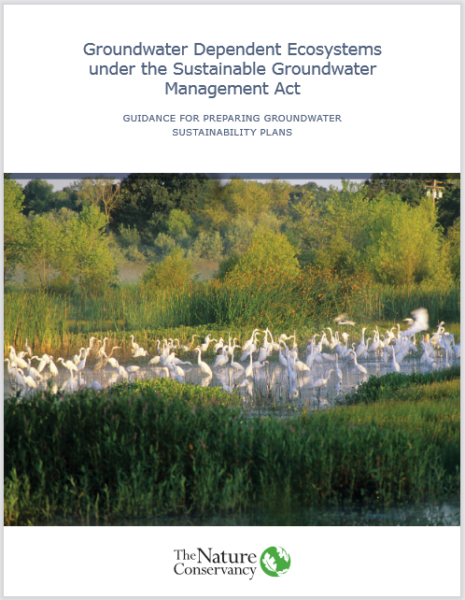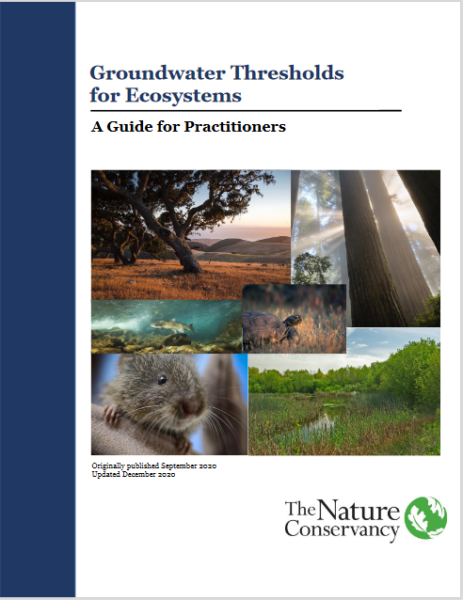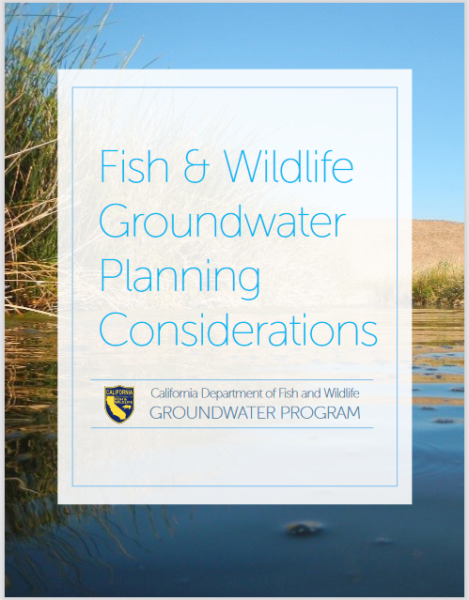The Groundwater Sustainability Plan Regulations provide a specific definition of a GDE as ‘ecological communities or species that depend on groundwater emerging from aquifers or on groundwater occurring near the ground surface.’
GDEs include springs, seeps, and the baseflow of rivers and streams, which often sustains surface flow during dry periods. GDEs commonly sustain a wide variety of plants and animals and are considered beneficial uses of interconnected surface water.
Key information
Introduction to Groundwater Dependent Ecosystems & Sustainable Groundwater Management
 The Nature Conservancy developed this guidance document to help local and state agencies, consultants, and stakeholders use the best available science to efficiently and cost-effectively identify and consider GDEs as required in GSPs. It provides a step-by-step guide that fits within the overall planning process established by SGMA. Includes downloadable worksheets.
The Nature Conservancy developed this guidance document to help local and state agencies, consultants, and stakeholders use the best available science to efficiently and cost-effectively identify and consider GDEs as required in GSPs. It provides a step-by-step guide that fits within the overall planning process established by SGMA. Includes downloadable worksheets.
Click here to download the report and related resources.
Groundwater Thresholds for Ecosystems: A Practitioner’s Guide
 The purpose of this document is to provide guidance on quantifying groundwater conditions that are protective of groundwater dependent ecosystems (GDEs). Quantitative groundwater thresholds and objectives are intended to protect GDEs when evaluating new water project proposals(e.g., new wells, water transfers, etc.), developing regional and local water management plans, or meeting legal requirements such as the Endangered Species Act.
The purpose of this document is to provide guidance on quantifying groundwater conditions that are protective of groundwater dependent ecosystems (GDEs). Quantitative groundwater thresholds and objectives are intended to protect GDEs when evaluating new water project proposals(e.g., new wells, water transfers, etc.), developing regional and local water management plans, or meeting legal requirements such as the Endangered Species Act.
In this document, we highlight five steps to quantify what groundwater levels are needed to avoid adverse impacts from groundwater use on GDEs. This document focuses on quantifying critical thresholds for ecosystems but does not cover setting triggers for actions to protect ecosystems from reaching those thresholds.
Although not the focus of this document, the guidance could also be useful for informing methods to set environmental criteria for groundwater–related activities, such as managed aquifer recharge and water funds.
Fish and Wildlife Groundwater Planning Considerations
 To achieve sustainability, GSAs must develop and implement effective groundwater management plans that consider the interests of all beneficial uses and users of groundwater, including environmental users of groundwater.
To achieve sustainability, GSAs must develop and implement effective groundwater management plans that consider the interests of all beneficial uses and users of groundwater, including environmental users of groundwater.
In many groundwater basins, fish and wildlife that rely on groundwater are among these beneficial uses and users. Many sensitive species and habitats comprise groundwater dependent ecosystems (GDEs), which are natural communities that rely on groundwater to sustain all or a portion of their water needs. The unsustainable use of groundwater can impact the shallow aquifers and interconnected surface waters on which GDEs depend and may lead to adverse impacts on fish and wildlife.
As trustee for California’s fish and wildlife resources, CDFW intends to engage as a stakeholder in groundwater planning processes (where resources are available) to represent the groundwater needs of GDEs and fish and wildlife beneficial uses and users of groundwater. The information provided here is intended to help local groundwater planners, groundwater planning proponents, and consultants, and CDFW staff work together to consider the needs of fish and wildlife when developing groundwater management plans and implementing SGMA.
Groundwater Resource Hub (The Nature Conservancy): Website with a wealth of resources on how to manage groundwater dependent ecosystems under SGMA.
Groundwater Program (CA Department of Fish and Wildlife)
Groundwater Dependent Ecosystems (US Forest Service)
Mapping Indicators of Groundwater Dependent Ecosystems (The Nature Conservancy) The first step to sustainably manage groundwater dependent ecosystems (GDEs) is to identify where they are.
Best Practices for using the Natural Communities Dataset (The Nature Conservancy) The NC Dataset identifies vegetation and wetland features that are good indicators of a GDE. This document highlights six best practices for using local groundwater data to confirm whether mapped features in the NC dataset are supported by groundwater.
ICONS database (The Nature Conservancy) This dataset provides information on the depth to groundwater and the likely presence of interconnected surface water (ISW) in the Central Valley.
Groundwater Dependent Ecosystems Rooting Depth Database (The Nature Conservancy) Plant rooting depth information can provide a useful insight on what groundwater levels may be needed to sustain GDEs.
Groundwater Dependent Ecosystem Pulse Tool (The Nature Conservancy) GDE Pulse allows groundwater managers to assess changes in groundwater dependent ecosystem (GDE) health using satellite, rainfall, and groundwater data.
